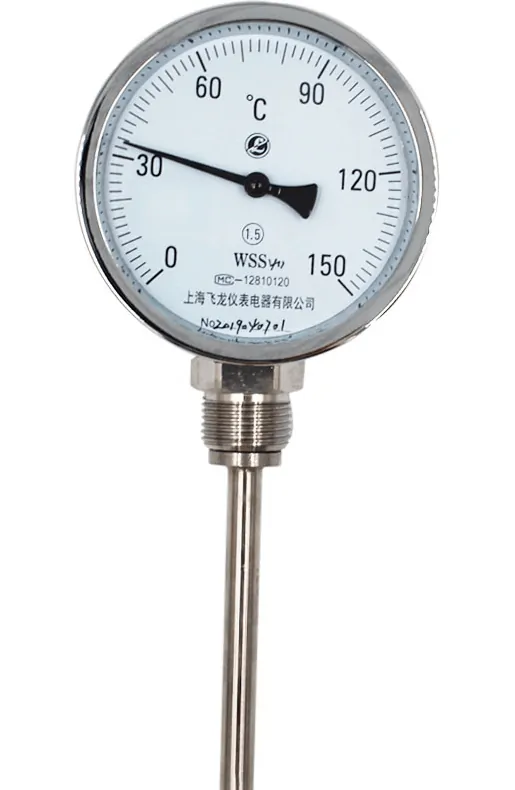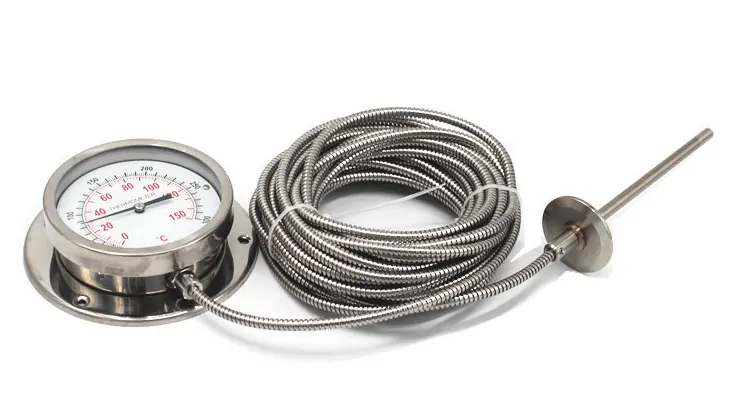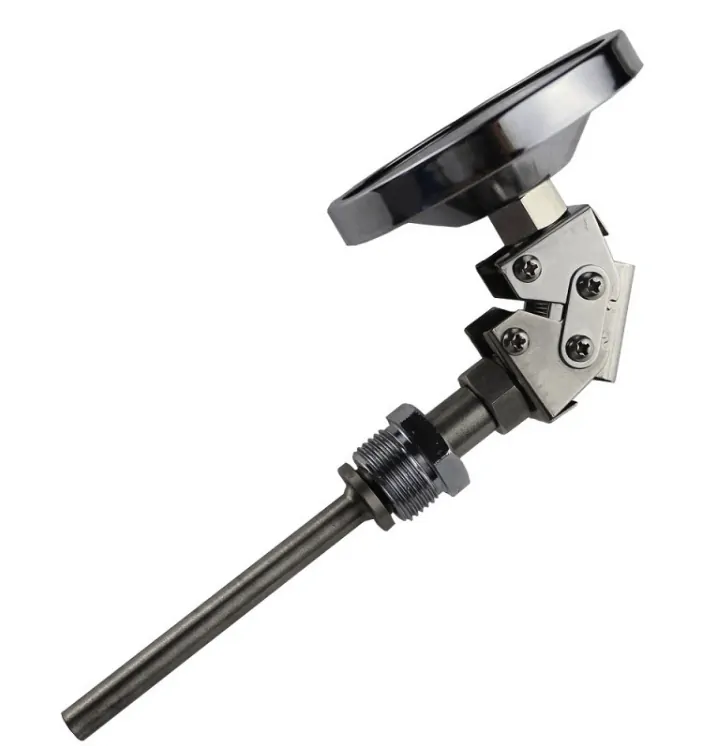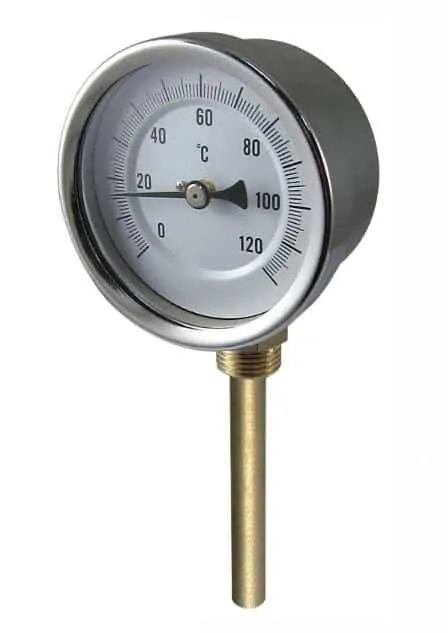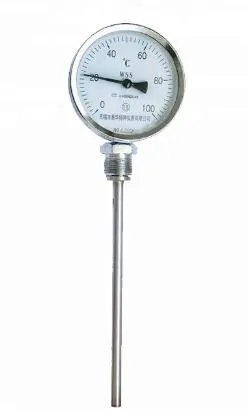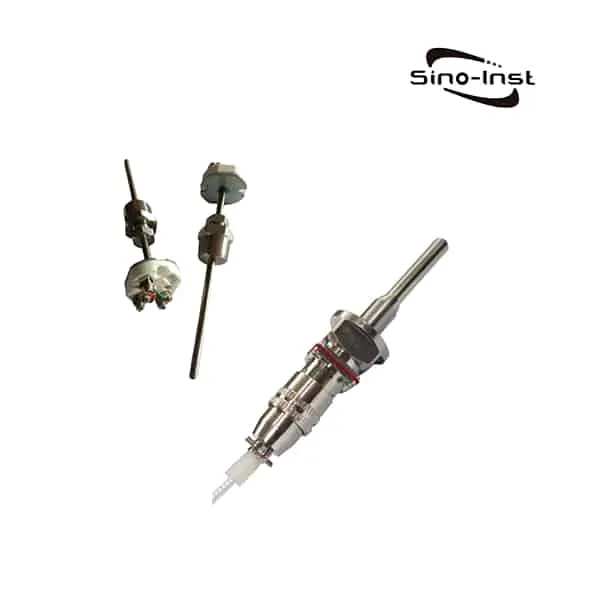Bimetallic thermometer is an on-site temperature detection instrument for measuring low and medium temperatures.
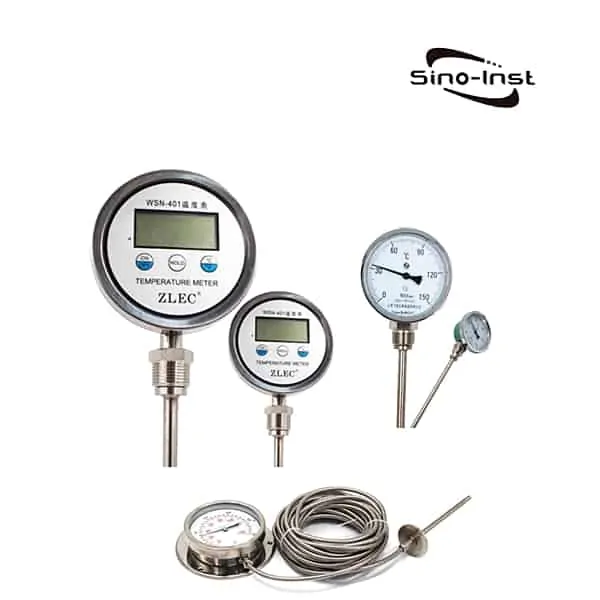
The bimetal thermometer is based on a bimetallic sheet wound into a circular bending shape. When one end is heated and expanded, it drives the pointer to rotate, and the working instrument displays the temperature value of the thermoelectric potential. Bimetal thermometer is an on-site temperature detection instrument for measuring low and medium temperatures. It can directly measure the temperature of liquid, steam and gaseous media in the range of -80℃~+500℃ in various production processes.
Sino-Inst offers a variety of bimetal thermometers for temperature measurement. If you have any questions, please contact our sales engineers.
Main technical parameters of Bimetallic Thermometers
- Product implementation standard: JB/T8803-1998;
- Nominal diameter of dial: 60,100,150;
- Accuracy grade: (1.0), 1.5;
- Thermal response time: ≤40s;
- Protection level: IP55;
- Angle adjustment error;
The angle adjustment error should not exceed 1.0% of its range; - Return difference: The return difference of the thermometer should not be greater than the absolute value of the basic error limit;
- Repeatability: The repeatability limit range of the thermometer should not be greater than 1/2 of the absolute value of the basic error limit;
- Temperature measurement range

Bimetallic thermometer of electric contact point
The electric contact bimetal thermometer is used in the production site to automatically control and alarm the temperature. Directly measure the temperature of body, steam and gaseous media in the range of -80℃~+500℃ in various production processes.
The electric contact bimetal thermometer uses the temperature change to drive the contact change when it is in contact with or disconnected from the upper and lower limit contacts. At the same time, the relay in the circuit is activated, thereby automatically controlling and alarming.
Explosion proof electric contact bimetallic thermometer

The bimetal thermometer can directly measure the temperature of body, steam and gas medium and solid surface in the range of -80℃~+500℃ in the process of explosives such as hydrocarbons and other explosives at the production site.
Main technical parameters
- Nominal diameter of dial: 100
- Thermal response time: ≤40s
- Explosion proof grade: dⅡBT4
- Rated power: 10VA
- Maximum operating voltage: 220V
- Maximum operating current: 0.7A
Remote Bimetallic thermometer

The bimetal thermometer and thermocouple (resistance) are integrated. It not only meets the needs of on-site temperature measurement, but also meets the needs of long-distance transmission. It can directly measure the temperature of liquid, steam and gas medium and solid surface in the range of -80℃~+500℃ in various production processes.
Main technical parameters
- Nominal diameter of dial: 100, 150
- Thermal response time: ≤40s
- Accuracy grade: (1.0), 1.5
- Thermocouple; Class I, 1.5℃; Class II, 2.5℃
- Thermal resistance: Class A, ±(0.15+0.005 ItI) Class B, ±(0.30+0.005 ItI)
- Protection level: IP55
Digital Thermometer/Transmitter
Digital Thermometer/Transmitter is practically used to measure medium and low temperature field detection instruments. It can be used to directly measure the temperature of gases such as liquids. Compared with glass mercury thermometers, it has the advantages of no mercury hazard, easy reading, strong and durable. It can directly replace double Metal, pressure type, glass mercury thermometer, etc. At the same time, the defects of bimetal thermometers cannot be bent and used restrictions are changed.
For the installation of bimetal thermometers, attention should be paid to accurate temperature measurement, safety and reliability, and convenient maintenance. And it does not affect equipment operation and production operations.
The above requirements must be met. When choosing the installation location and insertion depth of the thermal resistance, pay attention to the following A few points:
(1) In order to have sufficient heat exchange between the measuring end of the thermal resistance and the measured medium, the location of the measurement point should be selected reasonably and try to avoid installing thermal resistance near the dead corner of the valve, elbow, pipeline and equipment.
(2) Thermal resistors with protective sleeves have heat transfer and heat dissipation losses. In order to reduce measurement errors, thermocouples and thermal resistors should have sufficient insertion depth:
a. For the thermal resistance measuring the temperature of the fluid in the center of the pipeline. Generally, the measuring end should be inserted into the center of the pipeline (vertical installation or inclined installation). If the pipe diameter of the fluid to be measured is 200 mm, the insertion depth of the thermal resistance should be 100 mm;
b. For temperature measurement of high temperature, high pressure and high speed fluids (such as main steam temperature). In order to reduce the resistance of the protective sleeve to the fluid and prevent the protective sleeve from breaking under the action of the fluid.
The shallow insertion method of the protective tube or the hot sleeve type can be adopted Thermal resistance. Shallow plug-in thermal resistance protection sleeve, the depth of its insertion into the main steam pipe should not be less than 75mm. The standard insertion depth of thermal resistance is 100mm;
c. If you need to measure the temperature of the flue gas in the flue. Although the flue diameter is 4m, the insertion depth of the thermal resistance is 1 m;
d. When measuring the original insertion depth more than 1m, it should be installed vertically as far as possible. Or add support frame and protective sleeve.
Sino-Inst, Manufacuturer for Thermal Resistances, like: Armoured thermocouple, assembly thermocouple, explosion-proof thermocouple, etc.
Sino-Inst’s Thermal Resistances, made in China, Having good Quality, With better price. Our Temperature measurement instruments are widely used in China, India, Pakistan, US, and other countries.

Wu Peng, born in 1980, is a highly respected and accomplished male engineer with extensive experience in the field of automation. With over 20 years of industry experience, Wu has made significant contributions to both academia and engineering projects.
Throughout his career, Wu Peng has participated in numerous national and international engineering projects. Some of his most notable projects include the development of an intelligent control system for oil refineries, the design of a cutting-edge distributed control system for petrochemical plants, and the optimization of control algorithms for natural gas pipelines.


